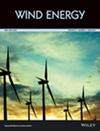Data‐driven modelling of turbine wake interactions and flow resistance in large wind farms
IF 3.3
3区 工程技术
Q3 ENERGY & FUELS
引用次数: 6
Abstract
Turbine wake and local blockage effects are known to alter wind farm power production in two different ways: (1) by changing the wind speed locally in front of each turbine; and (2) by changing the overall flow resistance in the farm and thus the so-called farm blockage effect. To better predict these effects with low computational costs, we develop data-driven emulators of the `local' or `internal' turbine thrust coefficient $C_T^*$ as a function of turbine layout. We train the model using a multi-fidelity Gaussian Process (GP) regression with a combination of low (engineering wake model) and high-fidelity (Large-Eddy Simulations) simulations of farms with different layouts and wind directions. A large set of low-fidelity data speeds up the learning process and the high-fidelity data ensures a high accuracy. The trained multi-fidelity GP model is shown to give more accurate predictions of $C_T^*$ compared to a standard (single-fidelity) GP regression applied only to a limited set of high-fidelity data. We also use the multi-fidelity GP model of $C_T^*$ with the two-scale momentum theory (Nishino \&Dunstan 2020, J. Fluid Mech. 894, A2) to demonstrate that the model can be used to give fast and accurate predictions of large wind farm performance under various mesoscale atmospheric conditions. This new approach could be beneficial for improving annual energy production (AEP) calculations and farm optimisation in the future.大型风电场中涡轮尾流相互作用和流动阻力的数据驱动建模
涡轮机尾流和局部阻塞效应以两种不同的方式改变风力发电场的发电量:(1)通过改变每个涡轮机前部的局部风速;(2)通过改变农场的整体流动阻力,从而产生所谓的农场阻塞效应。为了以较低的计算成本更好地预测这些影响,我们开发了数据驱动的模拟器,将“局部”或“内部”涡轮推力系数C_T^*$作为涡轮布局的函数。我们使用多保真高斯过程(GP)回归,结合低(工程尾流模型)和高保真(大涡模拟)模拟不同布局和风向的农场来训练模型。大量的低保真度数据加快了学习过程,高保真度数据保证了学习的准确性。与仅应用于有限的高保真数据集的标准(单保真)GP回归相比,经过训练的多保真GP模型显示出更准确的$C_T^*$预测。我们还使用了具有双尺度动量理论的多保真度GP模型(Nishino \&Dunstan 2020, J. Fluid Mech. 894, A2)来证明该模型可以用于快速准确地预测各种中尺度大气条件下的大型风电场性能。这种新方法可能有助于改善未来的年能源产量(AEP)计算和农场优化。
本文章由计算机程序翻译,如有差异,请以英文原文为准。
求助全文
约1分钟内获得全文
求助全文
来源期刊

Wind Energy
工程技术-工程:机械
CiteScore
9.60
自引率
7.30%
发文量
0
审稿时长
6 months
期刊介绍:
Wind Energy offers a major forum for the reporting of advances in this rapidly developing technology with the goal of realising the world-wide potential to harness clean energy from land-based and offshore wind. The journal aims to reach all those with an interest in this field from academic research, industrial development through to applications, including individual wind turbines and components, wind farms and integration of wind power plants. Contributions across the spectrum of scientific and engineering disciplines concerned with the advancement of wind power capture, conversion, integration and utilisation technologies are essential features of the journal.
 求助内容:
求助内容: 应助结果提醒方式:
应助结果提醒方式:


